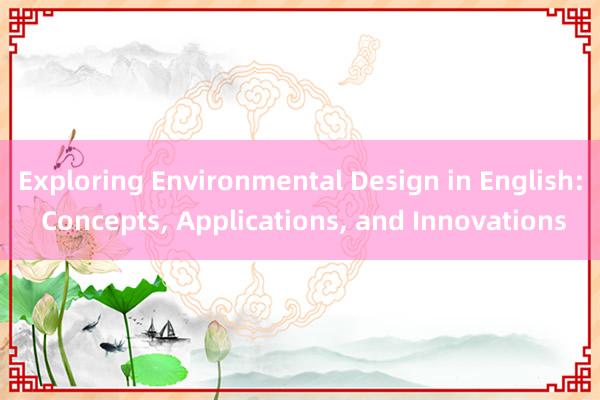时间:2024-10-08 09:06

### Exploring Environmental Design in English: Concepts, Applications, and Innovations
Environmental design魔都食探, a multidisciplinary field that integrates principles of architecture, urban planning, landscape architecture, and engineering, has become increasingly crucial in addressing the complex challenges posed by climate change, resource scarcity, and growing urban populations. This article delves into the exploration of environmental design concepts, their applications, and innovative approaches in English-speaking contexts.
#### Concepts in Environmental Design
At its core, 海口市江咔商贸有限公司 environmental design focuses on creating sustainable and livable environments through the strategic use of natural resources and technological advancements. Key concepts include:
1. **Sustainability**: Emphasizing the use of materials and designs that minimize environmental impact over time, 河北东恒国际贸易有限公司 promoting renewable resources and energy efficiency.
2. **Resilience**: Designing structures and systems to withstand and recover from environmental stresses such as natural disasters and climate change.
3. **Inclusivity**: Ensuring that designs are accessible and beneficial to all segments of society,首页-新昌宝颜料有限公司 including those with disabilities or from marginalized communities.
4. **Integration**: Blending human-made structures seamlessly with natural landscapes to enhance ecological health and human well-being.
#### Applications of Environmental Design
Environmental design concepts are applied across various scales, from small-scale residential projects to large urban developments. Some notable applications include:
- **Green Roofs and Walls**: Enhancing urban spaces with vegetation to reduce heat absorption, improve air quality, and provide habitats for wildlife.
安平县华成金属丝网制品有限公司- **Smart Cities**: Leveraging technology to optimize resource management,魔都食探 enhance public safety, and improve the quality of life for residents.
- **Water-sensitive Urban Design (WSUD)**: Implementing techniques that mimic natural water cycles to manage stormwater and reduce pollution.
- **Passive Solar Design**: Utilizing the sun's energy to regulate building temperatures, reducing heating and cooling needs.
#### Innovations in Environmental Design
Innovations are continuously shaping the future of environmental design, driven by advancements in technology and shifting societal priorities. Some recent trends include:
- **Biophilic Design**: Incorporating natural elements and views into indoor spaces to promote psychological and physical well-being.
- **Digital Twin Technologies**: Using virtual replicas of buildings and cities to simulate and optimize performance before actual construction.
- **Net-Zero Energy Buildings**: Designing structures that produce as much energy as they consume, often through advanced insulation, solar panels, and smart energy management systems.
- **Circular Economy Approaches**: Focusing on recycling, reuse, and repurposing materials to minimize waste and reduce environmental impact.
#### Conclusion
Environmental design, when approached through a lens of sustainability, resilience, inclusivity, and integration, holds immense potential for creating healthier, more equitable, and environmentally responsible communities. As English-speaking regions continue to lead global discussions and innovations in this field, the importance of interdisciplinary collaboration, technological advancement, and policy support becomes paramount. The future of environmental design promises not only to address pressing environmental issues but also to enrich human experiences and foster a more harmonious relationship between humans and the natural world.